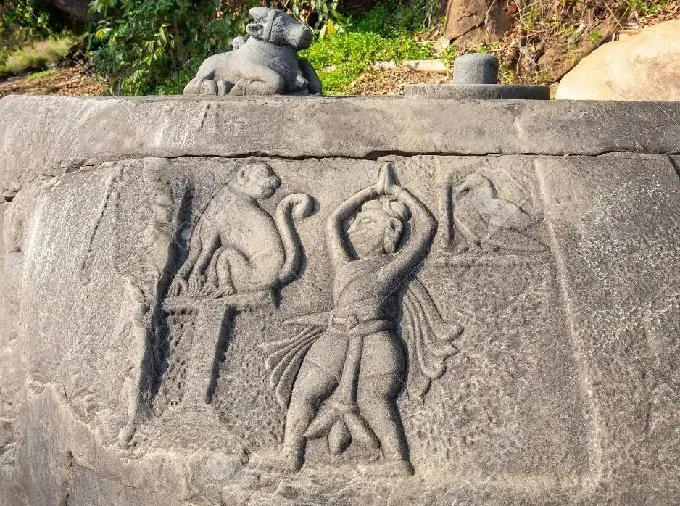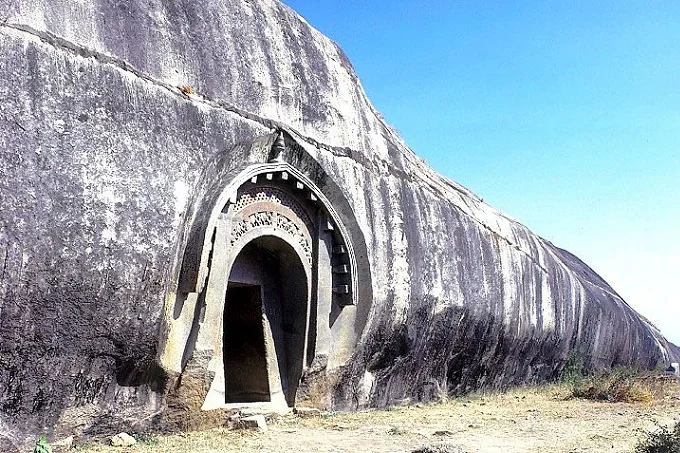Skeptics argue that there were no great civilizations with spectacular constructions in the past. They attempt to explain any weird item or a historical relic from their perspective, claiming that it was made by hand or that it was a natural creation. However, even the most adamant doubters and reasonable scientists cannot dispute the presence of sophisticated civilizations from the dawn of time.
10 famous artifacts of ancient civilizations
The Sahasralinga complex

On the Shalmala River in the Indian state of Karnataka, there is an ancient site named Sahasralinga. Hundreds of pilgrims flock here when the river’s water level decreases in the summer. A variety of fascinating stone images etched in time immemorial from under the sea are revealed. This, for example, is a fantastic education. Are you going to say it was handcrafted?
Barabar Caves
Barabar is the collective name for a series of caverns near the city of Gaya in the Indian state of Bihar. According to historians, they were formally produced in the 3rd century BC, once again by hand. Whether this is true, you must decide for yourself. Making a hard rock building with high ceilings, smooth walls, and seams that can’t be pierced by a razor blade, in our view, is still exceedingly difficult today.
South Stone Baalbek
Baalbek is a historical city in Lebanon. It has a wide variety of sights. The Temple of Jupiter, with its multi-ton marble columns, and the South Stone, a precisely hewn stone weighing 1500 tons, are the most astonishing. Science has no solutions to the questions of who and how such a monolith might have been created in time immemorial and for what objectives.
Reservoir Baray
In Angkor, Cambodia, West Baray is a man-made reservoir. The reservoir is 8 kilometers long and 2.1 kilometers wide, at a depth of 5 meters. It has existed from the beginning of time. It is thought that the ancient Khmers created the reservoir because of the correctness of the reservoir’s limits and the majesty of the work done. Nearby, there are two equally spectacular temple complexes: Angkor Wat and Angkor Thom, both of which have a very accurate plan. Modern scientists are baffled as to what technology the architects of the past used.
“A crew of French restorers has been operating in Angkor since 1906,” says Y. Iwasaki, head of the Geological Research Institute in Osaka, Japan. French specialists attempted to raise the stones back onto the steep slope in the 1950s. However, since the steep embankment’s angle is 40o, the embankment collapsed after the first 5 m high step was erected. To protect the earthen constructions, the French abandoned the concept of using ancient methods and built a concrete wall within the pyramid. “We don’t know how the ancient Khmers were able to construct such high and steep embankments today.”
Cumba Mayo Aqueduct
Cumba Mayo is approximately 3.3 kilometers above sea level and is situated near the Peruvian city of Cajamarca. Here are the ruins of an old aqueduct that was certainly not constructed by hand. It was believed to have been constructed prior to the Inca Empire’s ascent to power.
Cumbe-Mayo gets its name from the Quechua phrase Cumpi Mayu, which means “well-made water channel.” It is unknown what culture produced it, although it is thought to have occurred about 1500 AD. The Cumba Mayo Aqueduct is considered one of South America’s oldest constructions. It’s around 10 kilometers long. Furthermore, if there were any rocks in the way of the old water passage, unidentified builders carved a tunnel directly through them.
Sacsayhuaman and Ollantaytambo
Sacsayhuaman and Ollantaytambo are ancient monuments located in the Cuzco area of Peru, within the grounds of a large archaeological park. Although this park is 5,000 square meters in size, most of it was buried by an avalanche many years ago. The Incas are said to have constructed these cities using the most basic technologies available.
The massive stones of the stronghold, densely packed together, as well as the even signs of sawing stones in both ancient towns, are, nonetheless, astonishing. The Incas were astounded by the magnificence of these structures. The Incas themselves were amazed at the grandeur of these buildings. The Peruvian Inca historian Garcilaso de la Vega wrote about the Sacsayhuaman fortress: “It amazes with the size of the boulders of which it is composed; anyone who has not seen this himself will not believe that something can be built from such stones; they inspire terror to the one who examines them carefully.” Look for yourself at its remains and at the blocks from Ollantaytambo and see that it is simply impossible to create this by hand, without the help of high technologies.
Stones of the Moon
There is an intriguing attraction in the Cusco area, in the same archaeological site, named Killarumiyoc. This is a Quechua term that directly translates to “Moonstone.” It is said to be a holy site. Rituals, meditation, and soul cleaning are among the reasons why people come here. Pay notice to the distinctive, absolutely symmetrical design and the exceptional finish quality.
Saudi Arabia’s Al Naslaa stone
Al Naslaa, a well-known cut stone, is found in the Saudi Arabian region of Tayma. The absolutely straight, sliced line takes all of the researchers aback, which has completely smooth surfaces on both sides. It is unknown who carved this stone and how it was cut. Scientists believe that nature has attempted here – this is a perfectly flat line, they say – and that it is a result of weathering. This version, however, seems to be unworkable since no analogous structures exist in nature.
The stone of Ishi-no-Hoden
Near the Japanese city of Takasago is the famous huge megalith Ishi-no-Hoden. Its weight is about 600 tons. It is known that it was created before our era. The stone is a local landmark – and looking at its photographs and old drawings, you understand why it is so popular.
Mikerinos’ Pyramid
The Pyramid of Mikerin (or Menkaure) is located in Giza and is one of the Great Pyramids. Moreover, it is the lowest among them – only 66 m in height (half the size of the Cheops pyramid). But amazes its imagination no less than its famous neighbors. For the construction of the pyramid, huge monolithic blocks were used, the weight of one of them is about 200 tons. It still remains a mystery how it was delivered to the construction site. The quality of the finishing of the blocks outside and inside the pyramid, as well as the carefully processed tunnels and internal chambers, is also surprising.
In this pyramid in the 19th century, a mysterious basalt sarcophagus was discovered, which was decided to send to England. But on the way, the ship was caught in a storm and sank off the coast of Spain.
